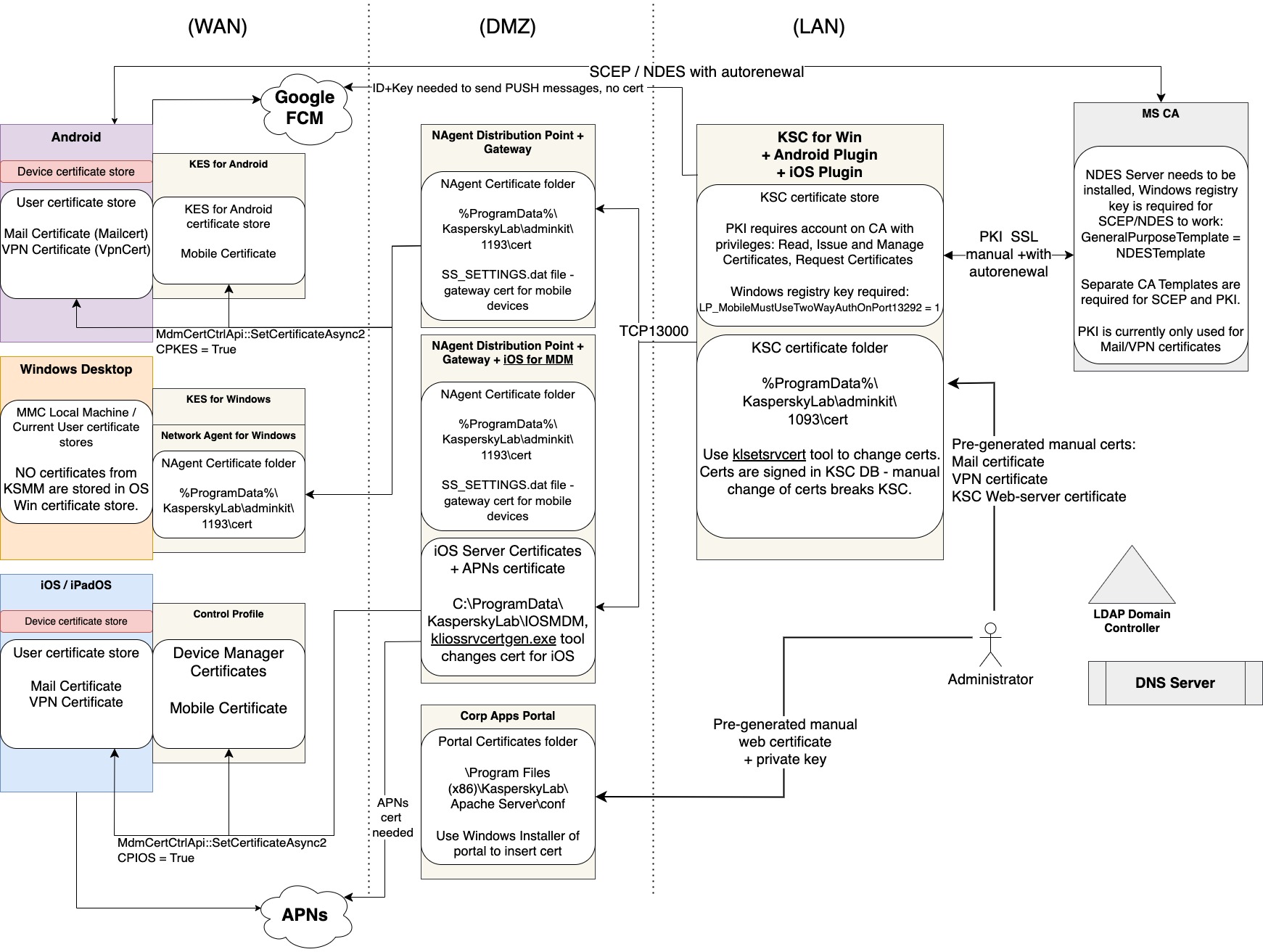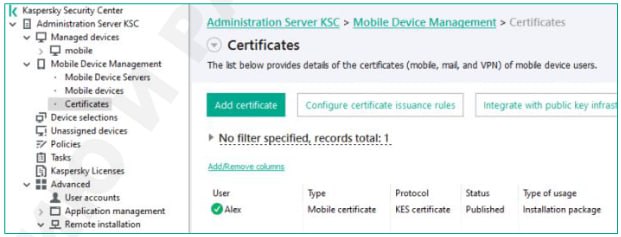OpenAPI
Links
Warning
KlAkOAPI Python Package is a wrapper over the regular REST API calls. I do NOT recommend its’ usage, because it does not cover all classes, parameters and attributes available.
Articles
Config / Auth
Access with OpenAPI requires 2 auth elements:
- Local technical user account login/password (Basic Auth method)
- KSC Server certificate verification (optional)
For KSC for Windows, server certificate is located at path:
%ProgramData%\KasperskyLab\adminkit\1093\cert\klserver.cer
Certificate needs to be copied to the machine, from which a script is run.
Login example
REST API Classic login:
import requests
import base64
import json
import urllib3
from pprint import pprint
urllib3.disable_warnings(urllib3.exceptions.InsecureRequestWarning)
ksc_server = "https://ksmm.demo.local:13299"
url = ksc_server + "/api/v1.0/login"
user = "user_api"
password = "P@ssw0rd"
data = {}
user = base64.b64encode(user.encode('utf-8')).decode("utf-8")
password = base64.b64encode(password.encode('utf-8')).decode("utf-8")
session = requests.Session()
auth_headers = {
'Authorization': 'KSCBasic user="' + user + '", pass="' + password + '", internal="1"',
'Content-Type': 'application/json',
}
response = session.post(url=url, headers=auth_headers, data=data, verify=False)
print(f'Server response = {response.status_code}')
KlAkOAPI Python Package Login:
import socket
import uuid
import datetime
from sys import platform
from KlAkOAPI.Params import KlAkArray, paramBinary, strToBin, dateTimeToStr
from KlAkOAPI.AdmServer import KlAkAdmServer
def GetServer():
server_address = 'ksmm.demo.local'
server_port = 13299
server_url = 'https://' + server_address + ':' + str(server_port)
username = 'user_api'
password = 'P@ssw0rd'
SSLVerifyCert = 'C:\\Lab\\klserver.cer'
server = KlAkAdmServer.Create(server_url, username, password, verify = SSLVerifyCert)
return server
# Call server login function:
server = GetServer()
TLS Ciphers
KSC for Win 14.x
SrvUseStrictSslSettings
Switch the supported versions of TLS and cipher suites is done using SrvUseStrictSslSettings flag:
klscflag -fset -pv ".core/.independent" -s Transport -n SrvUseStrictSslSettings -v <value> -t d
Flag SrvUseStrictSslSettings has values from 0 to 5:
0 - allow all TLS versions and cipher suites;
1 - SSL v2 turned OFF;
2 - SSL v2 + SSL v3 turned OFF;
3 - ONLY TLS v1.2;
4 - ONLY TLS v1.2, and ONLY a group of cipher suites with TLS_RSA_WITH_AES_256_GCM_SHA384 - used by default;
5 - ONLY TLS v1.2 and ONLY a selected group of cipher suites;
Options 0 - 3 are NOT recommended, used for compatibility purposes only.
SrvUseStrictSslSettings = 0
| Hexcode | Cipher Suite Name (OpenSSL) | KeyExch Encryption Bits | Cipher Suite Name |(IANA/RFC) |
TLS 1
xc014 ECDHE-RSA-AES256-SHA ECDH 521 AES 256 TLS_ECDHE_RSA_WITH_AES_256_CBC_SHA
x35 AES256-SHA RSA AES 256 TLS_RSA_WITH_AES_256_CBC_SHA
x84 CAMELLIA256-SHA RSA Camellia 256 TLS_RSA_WITH_CAMELLIA_256_CBC_SHA
xc013 ECDHE-RSA-AES128-SHA ECDH 521 AES 128 TLS_ECDHE_RSA_WITH_AES_128_CBC_SHA
x2f AES128-SHA RSA AES 128 TLS_RSA_WITH_AES_128_CBC_SHA
x96 SEED-SHA RSA SEED 128 TLS_RSA_WITH_SEED_CBC_SHA
x41 CAMELLIA128-SHA RSA Camellia 128 TLS_RSA_WITH_CAMELLIA_128_CBC_SHA
x07 IDEA-CBC-SHA RSA IDEA 128 TLS_RSA_WITH_IDEA_CBC_SHA
TLS 1.1
xc014 ECDHE-RSA-AES256-SHA ECDH 521 AES 256 TLS_ECDHE_RSA_WITH_AES_256_CBC_SHA
x35 AES256-SHA RSA AES 256 TLS_RSA_WITH_AES_256_CBC_SHA
x84 CAMELLIA256-SHA RSA Camellia 256 TLS_RSA_WITH_CAMELLIA_256_CBC_SHA
xc013 ECDHE-RSA-AES128-SHA ECDH 521 AES 128 TLS_ECDHE_RSA_WITH_AES_128_CBC_SHA
x2f AES128-SHA RSA AES 128 TLS_RSA_WITH_AES_128_CBC_SHA
x96 SEED-SHA RSA SEED 128 TLS_RSA_WITH_SEED_CBC_SHA
x41 CAMELLIA128-SHA RSA Camellia 128 TLS_RSA_WITH_CAMELLIA_128_CBC_SHA
x07 IDEA-CBC-SHA RSA IDEA 128 TLS_RSA_WITH_IDEA_CBC_SHA
TLS 1.2
xc030 ECDHE-RSA-AES256-GCM-SHA384 ECDH 521 AESGCM 256 TLS_ECDHE_RSA_WITH_AES_256_GCM_SHA384
xc028 ECDHE-RSA-AES256-SHA384 ECDH 521 AES 256 TLS_ECDHE_RSA_WITH_AES_256_CBC_SHA384
xc014 ECDHE-RSA-AES256-SHA ECDH 521 AES 256 TLS_ECDHE_RSA_WITH_AES_256_CBC_SHA
xcca8 ECDHE-RSA-CHACHA20-POLY1305 ECDH 521 ChaCha20 256 TLS_ECDHE_RSA_WITH_CHACHA20_POLY1305_SHA256
xc077 ECDHE-RSA-CAMELLIA256-SHA384 ECDH 521 Camellia 256 TLS_ECDHE_RSA_WITH_CAMELLIA_256_CBC_SHA384
x9d AES256-GCM-SHA384 RSA AESGCM 256 TLS_RSA_WITH_AES_256_GCM_SHA384
xc0a1 AES256-CCM8 RSA AESCCM8 256 TLS_RSA_WITH_AES_256_CCM_8
xc09d AES256-CCM RSA AESCCM 256 TLS_RSA_WITH_AES_256_CCM
x3d AES256-SHA256 RSA AES 256 TLS_RSA_WITH_AES_256_CBC_SHA256
x35 AES256-SHA RSA AES 256 TLS_RSA_WITH_AES_256_CBC_SHA
xc0 CAMELLIA256-SHA256 RSA Camellia 256 TLS_RSA_WITH_CAMELLIA_256_CBC_SHA256
x84 CAMELLIA256-SHA RSA Camellia 256 TLS_RSA_WITH_CAMELLIA_256_CBC_SHA
xc051 ARIA256-GCM-SHA384 RSA ARIAGCM 256 TLS_RSA_WITH_ARIA_256_GCM_SHA384
xc061 ECDHE-ARIA256-GCM-SHA384 ECDH 521 ARIAGCM 256 TLS_ECDHE_RSA_WITH_ARIA_256_GCM_SHA384
xc02f ECDHE-RSA-AES128-GCM-SHA256 ECDH 521 AESGCM 128 TLS_ECDHE_RSA_WITH_AES_128_GCM_SHA256
xc027 ECDHE-RSA-AES128-SHA256 ECDH 521 AES 128 TLS_ECDHE_RSA_WITH_AES_128_CBC_SHA256
xc013 ECDHE-RSA-AES128-SHA ECDH 521 AES 128 TLS_ECDHE_RSA_WITH_AES_128_CBC_SHA
xc0a0 AES128-CCM8 RSA AESCCM8 128 TLS_RSA_WITH_AES_128_CCM_8
xc09c AES128-CCM RSA AESCCM 128 TLS_RSA_WITH_AES_128_CCM
xc076 ECDHE-RSA-CAMELLIA128-SHA256 ECDH 521 Camellia 128 TLS_ECDHE_RSA_WITH_CAMELLIA_128_CBC_SHA256
x9c AES128-GCM-SHA256 RSA AESGCM 128 TLS_RSA_WITH_AES_128_GCM_SHA256
x3c AES128-SHA256 RSA AES 128 TLS_RSA_WITH_AES_128_CBC_SHA256
x2f AES128-SHA RSA AES 128 TLS_RSA_WITH_AES_128_CBC_SHA
xba CAMELLIA128-SHA256 RSA Camellia 128 TLS_RSA_WITH_CAMELLIA_128_CBC_SHA256
x96 SEED-SHA RSA SEED 128 TLS_RSA_WITH_SEED_CBC_SHA
x41 CAMELLIA128-SHA RSA Camellia 128 TLS_RSA_WITH_CAMELLIA_128_CBC_SHA
xc050 ARIA128-GCM-SHA256 RSA ARIAGCM 128 TLS_RSA_WITH_ARIA_128_GCM_SHA256
xc060 ECDHE-ARIA128-GCM-SHA256 ECDH 521 ARIAGCM 128 TLS_ECDHE_RSA_WITH_ARIA_128_GCM_SHA256
SrvUseStrictSslSettings = 1
| Hexcode | Cipher Suite Name (OpenSSL) | KeyExch Encryption Bits | Cipher Suite Name |(IANA/RFC) |
TLS 1
xc014 ECDHE-RSA-AES256-SHA ECDH 521 AES 256 TLS_ECDHE_RSA_WITH_AES_256_CBC_SHA
x35 AES256-SHA RSA AES 256 TLS_RSA_WITH_AES_256_CBC_SHA
xc013 ECDHE-RSA-AES128-SHA ECDH 521 AES 128 TLS_ECDHE_RSA_WITH_AES_128_CBC_SHA
x2f AES128-SHA RSA AES 128 TLS_RSA_WITH_AES_128_CBC_SHA
TLS 1.1
xc014 ECDHE-RSA-AES256-SHA ECDH 521 AES 256 TLS_ECDHE_RSA_WITH_AES_256_CBC_SHA
x35 AES256-SHA RSA AES 256 TLS_RSA_WITH_AES_256_CBC_SHA
xc013 ECDHE-RSA-AES128-SHA ECDH 521 AES 128 TLS_ECDHE_RSA_WITH_AES_128_CBC_SHA
x2f AES128-SHA RSA AES 128 TLS_RSA_WITH_AES_128_CBC_SHA
TLS 1.2
xc030 ECDHE-RSA-AES256-GCM-SHA384 ECDH 521 AESGCM 256 TLS_ECDHE_RSA_WITH_AES_256_GCM_SHA384
xc028 ECDHE-RSA-AES256-SHA384 ECDH 521 AES 256 TLS_ECDHE_RSA_WITH_AES_256_CBC_SHA384
xc014 ECDHE-RSA-AES256-SHA ECDH 521 AES 256 TLS_ECDHE_RSA_WITH_AES_256_CBC_SHA
xcca8 ECDHE-RSA-CHACHA20-POLY1305 ECDH 521 ChaCha20 256 TLS_ECDHE_RSA_WITH_CHACHA20_POLY1305_SHA256
x9d AES256-GCM-SHA384 RSA AESGCM 256 TLS_RSA_WITH_AES_256_GCM_SHA384
x3d AES256-SHA256 RSA AES 256 TLS_RSA_WITH_AES_256_CBC_SHA256
x35 AES256-SHA RSA AES 256 TLS_RSA_WITH_AES_256_CBC_SHA
xc02f ECDHE-RSA-AES128-GCM-SHA256 ECDH 521 AESGCM 128 TLS_ECDHE_RSA_WITH_AES_128_GCM_SHA256
xc027 ECDHE-RSA-AES128-SHA256 ECDH 521 AES 128 TLS_ECDHE_RSA_WITH_AES_128_CBC_SHA256
xc013 ECDHE-RSA-AES128-SHA ECDH 521 AES 128 TLS_ECDHE_RSA_WITH_AES_128_CBC_SHA
x9c AES128-GCM-SHA256 RSA AESGCM 128 TLS_RSA_WITH_AES_128_GCM_SHA256
x3c AES128-SHA256 RSA AES 128 TLS_RSA_WITH_AES_128_CBC_SHA256
x2f AES128-SHA RSA AES 128 TLS_RSA_WITH_AES_128_CBC_SHA
SrvUseStrictSslSettings = 2
| Hexcode | Cipher Suite Name (OpenSSL) | KeyExch Encryption Bits | Cipher Suite Name |(IANA/RFC) |
TLS 1
xc014 ECDHE-RSA-AES256-SHA ECDH 256 AES 256 TLS_ECDHE_RSA_WITH_AES_256_CBC_SHA
x35 AES256-SHA RSA AES 256 TLS_RSA_WITH_AES_256_CBC_SHA
x84 CAMELLIA256-SHA RSA Camellia 256 TLS_RSA_WITH_CAMELLIA_256_CBC_SHA
xc013 ECDHE-RSA-AES128-SHA ECDH 256 AES 128 TLS_ECDHE_RSA_WITH_AES_128_CBC_SHA
x2f AES128-SHA RSA AES 128 TLS_RSA_WITH_AES_128_CBC_SHA
x41 CAMELLIA128-SHA RSA Camellia 128 TLS_RSA_WITH_CAMELLIA_128_CBC_SHA
TLS 1.1
xc014 ECDHE-RSA-AES256-SHA ECDH 256 AES 256 TLS_ECDHE_RSA_WITH_AES_256_CBC_SHA
x35 AES256-SHA RSA AES 256 TLS_RSA_WITH_AES_256_CBC_SHA
x84 CAMELLIA256-SHA RSA Camellia 256 TLS_RSA_WITH_CAMELLIA_256_CBC_SHA
xc013 ECDHE-RSA-AES128-SHA ECDH 256 AES 128 TLS_ECDHE_RSA_WITH_AES_128_CBC_SHA
x2f AES128-SHA RSA AES 128 TLS_RSA_WITH_AES_128_CBC_SHA
x41 CAMELLIA128-SHA RSA Camellia 128 TLS_RSA_WITH_CAMELLIA_128_CBC_SHA
TLS 1.2
xc030 ECDHE-RSA-AES256-GCM-SHA384 ECDH 256 AESGCM 256 TLS_ECDHE_RSA_WITH_AES_256_GCM_SHA384
xc028 ECDHE-RSA-AES256-SHA384 ECDH 256 AES 256 TLS_ECDHE_RSA_WITH_AES_256_CBC_SHA384
xc014 ECDHE-RSA-AES256-SHA ECDH 256 AES 256 TLS_ECDHE_RSA_WITH_AES_256_CBC_SHA
xcca8 ECDHE-RSA-CHACHA20-POLY1305 ECDH 253 ChaCha20 256 TLS_ECDHE_RSA_WITH_CHACHA20_POLY1305_SHA256
xc077 ECDHE-RSA-CAMELLIA256-SHA384 ECDH 256 Camellia 256 TLS_ECDHE_RSA_WITH_CAMELLIA_256_CBC_SHA384
x9d AES256-GCM-SHA384 RSA AESGCM 256 TLS_RSA_WITH_AES_256_GCM_SHA384
xc0a1 AES256-CCM8 RSA AESCCM8 256 TLS_RSA_WITH_AES_256_CCM_8
xc09d AES256-CCM RSA AESCCM 256 TLS_RSA_WITH_AES_256_CCM
x3d AES256-SHA256 RSA AES 256 TLS_RSA_WITH_AES_256_CBC_SHA256
x35 AES256-SHA RSA AES 256 TLS_RSA_WITH_AES_256_CBC_SHA
xc0 CAMELLIA256-SHA256 RSA Camellia 256 TLS_RSA_WITH_CAMELLIA_256_CBC_SHA256
x84 CAMELLIA256-SHA RSA Camellia 256 TLS_RSA_WITH_CAMELLIA_256_CBC_SHA
xc051 ARIA256-GCM-SHA384 RSA ARIAGCM 256 TLS_RSA_WITH_ARIA_256_GCM_SHA384
xc061 ECDHE-ARIA256-GCM-SHA384 ECDH 253 ARIAGCM 256 TLS_ECDHE_RSA_WITH_ARIA_256_GCM_SHA384
xc02f ECDHE-RSA-AES128-GCM-SHA256 ECDH 256 AESGCM 128 TLS_ECDHE_RSA_WITH_AES_128_GCM_SHA256
xc027 ECDHE-RSA-AES128-SHA256 ECDH 256 AES 128 TLS_ECDHE_RSA_WITH_AES_128_CBC_SHA256
xc013 ECDHE-RSA-AES128-SHA ECDH 256 AES 128 TLS_ECDHE_RSA_WITH_AES_128_CBC_SHA
xc0a0 AES128-CCM8 RSA AESCCM8 128 TLS_RSA_WITH_AES_128_CCM_8
xc09c AES128-CCM RSA AESCCM 128 TLS_RSA_WITH_AES_128_CCM
xc076 ECDHE-RSA-CAMELLIA128-SHA256 ECDH 256 Camellia 128 TLS_ECDHE_RSA_WITH_CAMELLIA_128_CBC_SHA256
x9c AES128-GCM-SHA256 RSA AESGCM 128 TLS_RSA_WITH_AES_128_GCM_SHA256
x3c AES128-SHA256 RSA AES 128 TLS_RSA_WITH_AES_128_CBC_SHA256
x2f AES128-SHA RSA AES 128 TLS_RSA_WITH_AES_128_CBC_SHA
xba CAMELLIA128-SHA256 RSA Camellia 128 TLS_RSA_WITH_CAMELLIA_128_CBC_SHA256
x41 CAMELLIA128-SHA RSA Camellia 128 TLS_RSA_WITH_CAMELLIA_128_CBC_SHA
xc050 ARIA128-GCM-SHA256 RSA ARIAGCM 128 TLS_RSA_WITH_ARIA_128_GCM_SHA256
xc060 ECDHE-ARIA128-GCM-SHA256 ECDH 253 ARIAGCM 128 TLS_ECDHE_RSA_WITH_ARIA_128_GCM_SHA256
SrvUseStrictSslSettings = 3
| Hexcode | Cipher Suite Name (OpenSSL) | KeyExch Encryption Bits | Cipher Suite Name |(IANA/RFC) |
TLS 1.2
xc030 ECDHE-RSA-AES256-GCM-SHA384 ECDH 256 AESGCM 256 TLS_ECDHE_RSA_WITH_AES_256_GCM_SHA384
xc028 ECDHE-RSA-AES256-SHA384 ECDH 256 AES 256 TLS_ECDHE_RSA_WITH_AES_256_CBC_SHA384
xc014 ECDHE-RSA-AES256-SHA ECDH 256 AES 256 TLS_ECDHE_RSA_WITH_AES_256_CBC_SHA
xcca8 ECDHE-RSA-CHACHA20-POLY1305 ECDH 253 ChaCha20 256 TLS_ECDHE_RSA_WITH_CHACHA20_POLY1305_SHA256
xc077 ECDHE-RSA-CAMELLIA256-SHA384 ECDH 256 Camellia 256 TLS_ECDHE_RSA_WITH_CAMELLIA_256_CBC_SHA384
x9d AES256-GCM-SHA384 RSA AESGCM 256 TLS_RSA_WITH_AES_256_GCM_SHA384
xc0a1 AES256-CCM8 RSA AESCCM8 256 TLS_RSA_WITH_AES_256_CCM_8
xc09d AES256-CCM RSA AESCCM 256 TLS_RSA_WITH_AES_256_CCM
x3d AES256-SHA256 RSA AES 256 TLS_RSA_WITH_AES_256_CBC_SHA256
x35 AES256-SHA RSA AES 256 TLS_RSA_WITH_AES_256_CBC_SHA
xc0 CAMELLIA256-SHA256 RSA Camellia 256 TLS_RSA_WITH_CAMELLIA_256_CBC_SHA256
x84 CAMELLIA256-SHA RSA Camellia 256 TLS_RSA_WITH_CAMELLIA_256_CBC_SHA
xc051 ARIA256-GCM-SHA384 RSA ARIAGCM 256 TLS_RSA_WITH_ARIA_256_GCM_SHA384
xc061 ECDHE-ARIA256-GCM-SHA384 ECDH 253 ARIAGCM 256 TLS_ECDHE_RSA_WITH_ARIA_256_GCM_SHA384
xc02f ECDHE-RSA-AES128-GCM-SHA256 ECDH 256 AESGCM 128 TLS_ECDHE_RSA_WITH_AES_128_GCM_SHA256
xc027 ECDHE-RSA-AES128-SHA256 ECDH 256 AES 128 TLS_ECDHE_RSA_WITH_AES_128_CBC_SHA256
xc013 ECDHE-RSA-AES128-SHA ECDH 256 AES 128 TLS_ECDHE_RSA_WITH_AES_128_CBC_SHA
xc0a0 AES128-CCM8 RSA AESCCM8 128 TLS_RSA_WITH_AES_128_CCM_8
xc09c AES128-CCM RSA AESCCM 128 TLS_RSA_WITH_AES_128_CCM
xc076 ECDHE-RSA-CAMELLIA128-SHA256 ECDH 256 Camellia 128 TLS_ECDHE_RSA_WITH_CAMELLIA_128_CBC_SHA256
x9c AES128-GCM-SHA256 RSA AESGCM 128 TLS_RSA_WITH_AES_128_GCM_SHA256
x3c AES128-SHA256 RSA AES 128 TLS_RSA_WITH_AES_128_CBC_SHA256
x2f AES128-SHA RSA AES 128 TLS_RSA_WITH_AES_128_CBC_SHA
xba CAMELLIA128-SHA256 RSA Camellia 128 TLS_RSA_WITH_CAMELLIA_128_CBC_SHA256
x41 CAMELLIA128-SHA RSA Camellia 128 TLS_RSA_WITH_CAMELLIA_128_CBC_SHA
xc050 ARIA128-GCM-SHA256 RSA ARIAGCM 128 TLS_RSA_WITH_ARIA_128_GCM_SHA256
xc060 ECDHE-ARIA128-GCM-SHA256 ECDH 253 ARIAGCM 128 TLS_ECDHE_RSA_WITH_ARIA_128_GCM_SHA256
SrvUseStrictSslSettings = 4 (default)
| Hexcode | Cipher Suite Name (OpenSSL) | KeyExch Encryption Bits | Cipher Suite Name |(IANA/RFC) |
TLS 1.2
xc030 ECDHE-RSA-AES256-GCM-SHA384 ECDH 256 AESGCM 256 TLS_ECDHE_RSA_WITH_AES_256_GCM_SHA384
xc028 ECDHE-RSA-AES256-SHA384 ECDH 256 AES 256 TLS_ECDHE_RSA_WITH_AES_256_CBC_SHA384
xcca8 ECDHE-RSA-CHACHA20-POLY1305 ECDH 256 ChaCha20 256 TLS_ECDHE_RSA_WITH_CHACHA20_POLY1305_SHA256
x9d AES256-GCM-SHA384 RSA AESGCM 256 TLS_RSA_WITH_AES_256_GCM_SHA384
xc02f ECDHE-RSA-AES128-GCM-SHA256 ECDH 256 AESGCM 128 TLS_ECDHE_RSA_WITH_AES_128_GCM_SHA256
xc027 ECDHE-RSA-AES128-SHA256 ECDH 256 AES 128 TLS_ECDHE_RSA_WITH_AES_128_CBC_SHA256
SrvUseStrictSslSettings = 5
| Hexcode | Cipher Suite Name (OpenSSL) | KeyExch Encryption Bits | Cipher Suite Name |(IANA/RFC) |
TLS 1.2
xc030 ECDHE-RSA-AES256-GCM-SHA384 ECDH 256 AESGCM 256 TLS_ECDHE_RSA_WITH_AES_256_GCM_SHA384
xc028 ECDHE-RSA-AES256-SHA384 ECDH 256 AES 256 TLS_ECDHE_RSA_WITH_AES_256_CBC_SHA384
xcca8 ECDHE-RSA-CHACHA20-POLY1305 ECDH 256 ChaCha20 256 TLS_ECDHE_RSA_WITH_CHACHA20_POLY1305_SHA256
xc02f ECDHE-RSA-AES128-GCM-SHA256 ECDH 256 AESGCM 128 TLS_ECDHE_RSA_WITH_AES_128_GCM_SHA256
xc027 ECDHE-RSA-AES128-SHA256 ECDH 256 AES 128 TLS_ECDHE_RSA_WITH_AES_128_CBC_SHA256




